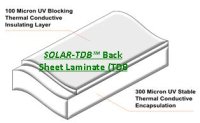Instant Melt-Encapsulation Back Sheet Reduces the Cycle Times by a Factor of 10.
In traditional Solar Panel manufacturing, a PVF/PET/PVF (T/P/T) back sheet is used in layer with an EVA encapsulant for protecting and encapsulating the back side of the solar panel. The layers are co-laminated with the front sheet that also includes an EVA layered over glass sheet. This lamination process is done at temperatures of 140-160°C under vacuum for up to 15-30 minutes. Both the layering and the vacuum lamination processes are costly because they are difficult to be automated. In addition, the reliability of the EVA under heat-moisture conditions is still an unknown factor.
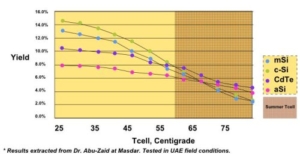
Ability to dissipate heat via a thermally conductive back sheet that incorporates a metal heat spreader (insulated metal back sheet) can reduce the temperature of operation by as many as 20-30C with resulting efficiency improvement from 5% to 10%.
AIT SOLAR-IMB™ (insulating metal back sheet) SOLAR-TDB™ (thermal dissipative without metal layer) back sheets are thermally dissipative thermoplastic laminates that provide instant melt-encapsulating capability for the backside of the solar modules while providing mechanical strength and electrical insulation as good as that of T/P/T. This melt-encapsulation processing without the need for curing enables the roll-to-roll lamination production of thin film solar panels. As well, these melt-encapsulating processes with UV resistant moisture-resistant materials dramatically enhance the processing and performance of solar panels.
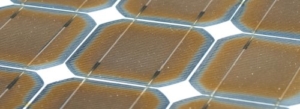
AIT thermally conductive insulated metal back sheet (IMB™) incorporates the strength and heat spreading capability of a 3-5 mil aluminum sheet and electrical insulating and moisture resistance of modified polyethylene and PVDF while providing more than a 10 fold increase in thermal conductivity over a traditional EVA encapsulated TPT back sheet.
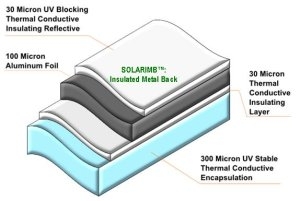
- SOLAR-IMB™ and SOLAR-TDB™ back encapsulation sheet adhesive instantly melt bonds to solar cells without an EVA interface layer during the same vacuum lamination process for solar panel. The SOLAR-IMB™ and SOLAR-TDB™ are ideal for both thin film and m-Si and p-Si solar panels. The ambient bond strength to silicon backside and metallization is well over 1000 psi and maintains at least 50% of the mechanical strength up to 85°C.
- SOLAR-IMB™ is a laminate of SG7115/Aluminum Foil/SC7135 laminate to provide the highest thermal dissipative capability with the use of an aluminum outer skin while providing more than 1500V insulation. The SOLAR-IMB™ laminate plus SG7115/Aluminum Foil/SC7135 laminate also increases the metal moisture barrier contributing to the long term reliability of the thin film solar panel.
- SOLAR-TDB™ is a single ply of SG7115/SG7135 melt-encapsulation sheet to provide good thermal dissipative capability and more than 1500V insulation. It replaces both T/P/T and EVA in traditional solar panels.
- RoHS, REACH and WEEE compliant that meets UL94V-0 rating.
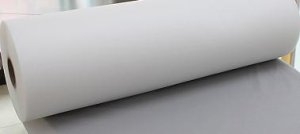
AIT thermally conductive insulated metal back sheet SOALR-IMB™ 7135 and SOLAR-TDB™ 7145 are both produced using single ply construction to eliminate the costs and errors in layering operation in panel manufacturing
Properties of SOLAR-IMB™ Back Sheet Laminate (IMB™ 7135)
Thermally Conductive Insulated Metal Back Sheet:
- Laminate of modified PVDF with embedded thermal conductivity
- Aluminum backing to optimize the thermal dissipation with normal breeze
- Modified and thermal coating on the aluminum backing to maintain long-term reliability
Low Moisture ingression from Edges
- Enable and ideal for frameless panel construction
- Compatible with the use of aluminum honeycomb structure to optimize the thermal dissipation and mechanical integrity
Outstanding Compatibility and Melt-Bonding Adhesion to Solar Cells and Metal Tabs
- Melt-flow and encapsulate tin-plated copper tab of 0.2 mm (8 mil) thick
- Melt-flow and encapsulate SOLAR-TAB™ (melt-flow conductive adhesive on passivated popper)
Outstanding bond strength and compatibility with AIT transparent fluorinated PVDF front sheet (ST7130)
Molecularly compatible and high bond strength to cross-linkable polyolefin front sheet encapsulant
Good compatibility and melt-bonding adhesion to traditional EVA front sheet encapsulant.
| SOLAR-IMB™ Back Sheet Laminate (IMB™ 7135) | |
|---|---|
| Electrical Resistivity | >1014 ohm-cm |
| Dielectric Strength of Laminate (Volts) | >1500 V |
| Elastic Modulus (psi) | 20,000 psi |
| Device Push-off Strength with Solar Cells (psi) | >1000 |
| Cured Density of Composite Dielectric (gm/cc) | 1.8 |
| Thermal Conductivity | > 1.6 W/m-°C |
| Linear Thermal Expansion Coefficient (ppm/°C) | 90 (X-Y=Z, Isotropic) |
| Maximum Continuous Operation Temp. (°C) | > 130 |
| Elongation Before Breakage | 300% |
| Recommended Melt-Lamination Pressure/Temperature/Time (psi/°C/Second) | >14/>140/>0.5 |
SOLAR-GRIP™: UV Resistant Single Ply Back Sheet Encapsulant
- Instant Melt-Bonding Encapsulating and UV Resistant Coated Back Sheet
- No “Pot- or Shelf-Life,” No Curing or Post Curing or EVA Based Chemical Reactivity
SG7115 is a high melt-flow encapsulating back sheet and encapsulant combination single ply material. SG 7115 melt-flows at a melting temperature above 130°C and “re-crystallizes” to provide mechanical strength up to 105°C.
Curing and post-curing chemical fastening process is replaced by the physical-fastening of the melt-crystallites built into the polymer network.
SG7115 is comprises of a 3 mil thick PVDF polymer alloy that blocks UV at both a molecular and microscopic scale with white pigments to provide 100% reflectivity to UV.
The inside encapsulant layer of SG7115 is high flow polyethylene alloy with a bond strength of over 1000 psi shear bond strength to backside metallization and silicon. SG7115 is also compatible and forms strong bonds with a traditional EVA or polyolefin based front sheet encapsulant.
The combination of PVDF and polyethylene structure not only provides outstanding block to UV induced degradation and moisture ingress, but it absorbs very low moisture that degrades most panel performance.
Properties of SOLAR-GRIP™ Back Sheet Encapsulant (SG 7115)
- Modified polyethylene single ply encapsulant and back sheet
- Good melt-bonding adhesion to solar cells, metal tabs and ST7130 front sheet
- Outstanding compatibility and melt-bonding adhesion to EVA and polyolefin encapsulant
| SOLAR-GRIP™ Back Sheet Encapsulant (SG 7115) | |
|---|---|
| Electrical Resistivity | >1014 ohm-cm |
| Dielectric Strength of Laminate (Volts) | >1500 V |
| Elastic Modulus (psi) | 20,000 psi |
| Device Push-off Strength with Solar Cells (psi) | >1000 |
| Cured Density of Composite Dielectric (gm/cc) | 1.6 |
| Thermal Conductivity | > 1.5 W/m-°C |
| Linear Thermal Expansion Coefficient (ppm/°C) | 95 (X-Y=Z, Isotropic) |
| Maximum Continuous Operation Temp. (°C) | >105 |
| Elongation Before Breakage | 300% |
| Recommended Melt-Lamination Pressure/Temperature/Time (psi/°C/Second) | >14/>140/>0.5 |
For a recommendation, information or assistance, please contact AIT sales and engineering:
AIT technical sales and service department can also be reached at: 1-609-799-9388 or 1-800-735-5040 (EST) and Fax: 609-799-9308


